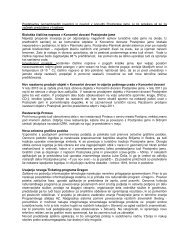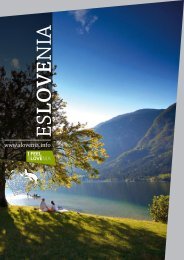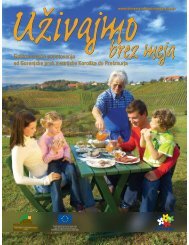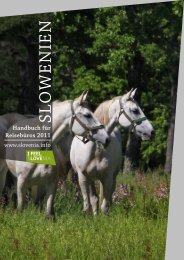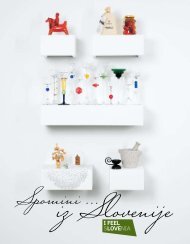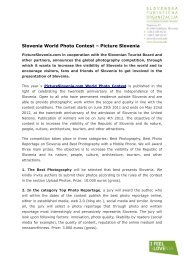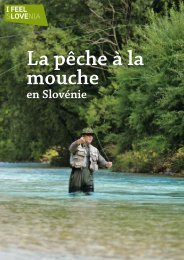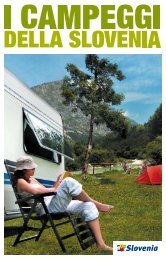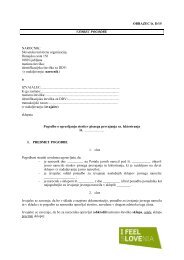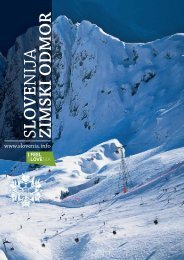Create successful ePaper yourself
Turn your PDF publications into a flip-book with our unique Google optimized e-Paper software.
<strong>ISTR</strong><strong>IA</strong><br />
<strong>SLO</strong>VEN<strong>IA</strong><br />
Koper Izola<br />
Piran Portorož<br />
www.slovenia.info
First-hand experience and photographs<br />
tell the story of Slovenian<br />
Istria better than words. The eye<br />
glistens with excitement, the soul<br />
yearns to travel. Travelling to this<br />
part of the world is possible by road,<br />
by rail, by sea and by air. Slovenian<br />
Istria is located on the meeting point<br />
of the Karst edge to the east, the<br />
Adriatic Sea to the west and the<br />
Bay of St. Bartholomew to the north.<br />
It borders on two neighbouring countries:<br />
Italy and Croatia, and is home to<br />
people of different nationalities.<br />
The stories of Slovenian Istria stretch<br />
a long way back, to the times of<br />
the Roman Empire and further.<br />
The remains of the Roman Empire<br />
can be found in the hamlets in the<br />
background of Koper, Izola and Piran,<br />
coastal towns bearing remains of the<br />
times long gone. Ancient atmosphere<br />
Slovenian<br />
Istria<br />
A place where you start to write<br />
the story of your own experience.<br />
can be felt in cobbled streets,<br />
squares, churches, houses and in the<br />
vibrations of everyday life.<br />
Istrian people tell the story of their<br />
homeland. They live in harmony with<br />
the soil, not always hospitable, yet<br />
rewarding hard work. They are fortunate<br />
to enjoy a moderate climate<br />
with mild winters and warm summers,<br />
enabling them to grow olive trees,<br />
vines and many different kinds of<br />
fruit, the basis of Istrian cuisine, not<br />
extravagant but a simple and healthy<br />
culinary and oenological art of food<br />
preparation. Fishing used to be an<br />
important part of everyday life, now,<br />
however, the number of fishermen is<br />
decreasing.<br />
Although the territory of Slovenia<br />
seems homogenous at first, it is<br />
nevertheless quite various, when you<br />
look at the picturesque landscape<br />
of Šavrinski hills, Bržanija, the Karst<br />
Edge and 47 kilometres of coastline.<br />
They each have special features but<br />
they are all parts of Slovenia's attractive<br />
seaside tourist resorts, famous<br />
for their diversity, unspoilt<br />
nature, kind people, rich cultural<br />
heritage and lively creativity, welldeveloped<br />
yet discreet tourist offer. A<br />
haven for your heart and soul. A place<br />
where you start to write the story of<br />
your own experience.<br />
Slovenian<br />
Istria<br />
02
Koper<br />
in the past and today<br />
The history of Koper goes back to the<br />
times of the Middle Bronze Age, 1500<br />
years B.C. In the past, Koper was an<br />
island, first inhabited in pre-Roman<br />
and Roman times.<br />
Aegida, Capris, Justinopolis, Insula<br />
Capraria, Caput Histriae, Capo D'Istria<br />
are the various names of Koper,<br />
whose image and name were altered<br />
throughout history by different rulers<br />
and states. Of all Slovenian coastal<br />
towns, Koper underwent the greatest<br />
number of changes and progressed a<br />
long way from the stony Goat Island<br />
to the economic centre of Slovenian<br />
Istra. Its modern image has deep<br />
historic roots and it is quite an art to<br />
bring together all these influences.<br />
In Roman times, the town was called<br />
Capris, in the times of Pope Gregory<br />
I it was Insula Capraria (the Goat<br />
Island), in Byzantine era it was called<br />
Justinopolis, the patriarchs of Aquilea<br />
named it Caput Histriae. Only in the<br />
times of the Venetian Republic<br />
its name was changed to Italian<br />
language: Capodistria. During the<br />
long Venetian rule, Koper underwent<br />
the most significant economic and<br />
cultural changes, which can still<br />
be felt today. The modern city of<br />
Koper is a member of the Slovenian<br />
Association of Historic Towns.<br />
Every cobblestone of the city streets<br />
speaks of the past. Renovated and<br />
restored old buildings speak of the<br />
respect local people feel for the past.<br />
The most important periods were the<br />
times before World War I, the time<br />
of Napoleonic and Habsburg rule,<br />
the time when the saltpans were<br />
reduced in size and Koper was no<br />
longer an island. Its development<br />
was influenced significantly by<br />
the establishing of land and sea<br />
connections with Trieste and Poreč.<br />
After World War II, in the times<br />
of great political changes, Koper<br />
became the economic centre of the<br />
region, a meeting point of nautical,<br />
seaside and sports tourism.<br />
Various cultural events give<br />
life to its streets and squares<br />
all year round, especially in the<br />
summer months. Last but not<br />
least, the establishing of the young<br />
University of Primorska, gives this<br />
city of abundant past, daring<br />
present and optimistic future a<br />
special kind of charm.<br />
Aegida, Capris, Justinopolis, Insula Capraria, Caput<br />
Histriae, Capo D'Istria, Koper.<br />
Slovenian<br />
Istria<br />
04
Izola<br />
in the past and today<br />
Two thousand years B. C. members<br />
of the Illyrian tribe of Histri were the<br />
first known inhabitants of Istria to<br />
build fortified settlements in this<br />
territory. Their remains can still be<br />
found in the village Kaštelir nad<br />
Kortami above Izola. Overlooking the<br />
neighbouring hills, the village has<br />
a wonderful view of the smallest of<br />
Istrian towns, the town which used to<br />
be an island: Izola.<br />
In the Italian language, Izola (isola)<br />
means 'an island'. Although in the<br />
course of time, the island became<br />
a part of the mainland, its story is<br />
closely linked to the sea. Being a fish-<br />
ing town, it was the home of the first<br />
fish-canning factory. Despite its former<br />
'sleeping beauty' status, known<br />
as the home of fishermen and<br />
workers, Izola has developed into a<br />
popular tourist resort. It is most appreciated<br />
by young families, sportsmen<br />
and retired people, who love to<br />
return here all year round. The motto<br />
of the modern tourist offer in Izola<br />
is that something is not good for the<br />
tourists if it is not good for its people,<br />
resulting in a somewhat more gentle<br />
approach to tourism.<br />
Numerous art galleries and pleasant<br />
inns can be found when walking along<br />
the streets of the old city core. The<br />
town also offers a variety of cultural<br />
events, many of which depict old<br />
traditions and customs of the city<br />
and its surrounding villages. This is<br />
also the home of the delicious Istrian<br />
cuisine and excellent wines.<br />
Izola is a picturesque mosaic of<br />
tradition, history, architectural sights<br />
and hospitable people, a place of<br />
harmonious coexistence of different<br />
nationalities. People of Izola carry<br />
their hometown in their hearts<br />
wherever they go.<br />
Izola is a picturesque mosaic of tradition,<br />
history, architectural sights<br />
and hospitable people<br />
Slovenian<br />
Istria<br />
06
Piran<br />
in the past and today<br />
Piran is a very special, precious city.<br />
It is the best preserved cultural<br />
monument of Slovenian Istria and<br />
the closest neighbour of Portorož, the<br />
luxurious city of flowers.<br />
Each time one looks at Piran from<br />
a distance or from the air, one is<br />
overcome by a feeling of surprise.<br />
Loved by the eyes of the people and<br />
by the eye of the camera, its image<br />
is known all over the world. However,<br />
it is also a great pleasure to enjoy all<br />
the things that cannot be seen from<br />
afar. When you visit Piran, you should<br />
take a closer look at its architecture,<br />
influenced by the Venetian<br />
Republic, which left its mark on most<br />
Istrian towns.<br />
Throughout time, Piran maintained<br />
the clustered medieval structure narrow<br />
winding streets, houses huddled<br />
close together, rising in cascades, the<br />
contact with the sea, numerous<br />
squares and churches.<br />
Tartini Square is the gem found in<br />
the very centre of Piran. It was named<br />
after the famous violinist and composer<br />
Giuseppe Tartini, who made<br />
the town world-famous. His statue is<br />
located in the centre of the square.<br />
The city is surrounded by a circular<br />
wall. Piran is a member of the European<br />
Walled Cities Association.<br />
The city of Piran is a national historical<br />
monument. People earn their<br />
living mainly by tourism. Numerous<br />
events take place all year<br />
round in the open and in magnificent<br />
buildings named after famous<br />
people from Piran. The Church of St.<br />
George, the patron saint of Piran,<br />
rises above the town. From its lookout<br />
tower you have a wonderful view of<br />
Piran and its surroundings and all the<br />
way across the sea to the Croatian<br />
and Italian coast.<br />
Two hotels, a youth hostel, a number<br />
of private rooms, churches, galleries,<br />
museums and Piran Aquarium invite<br />
you to come and see for yourself.<br />
You will not regret it.<br />
Piran is a very<br />
special,<br />
precious city.<br />
Each time one looks<br />
at Piran from a<br />
distance or from<br />
the air, one is overcome<br />
by a feeling of surprise.<br />
Slovenian<br />
Istria<br />
08
The countryside<br />
of Slovenian Istria<br />
Just as a person is identified by their<br />
name and surname, towns in Slovenian<br />
Istria cannot exist without their<br />
countryside, forming a geographic<br />
and social unity.<br />
In the surroundings of Koper,<br />
Slovenian most important contact<br />
with the sea, there are many villages<br />
complementing Koper with their special<br />
features.<br />
Črni Kal is the first Istrian village<br />
on the way from the mainland to the<br />
Mediterranean Istria. Here you can<br />
see the remains of the oldest Slovenian<br />
farmhouse, the Benko house,<br />
from the 15th century. The village is<br />
also known for the slanting church<br />
tower of the church of St. Valentine.<br />
Crossing the Črni Kal viaduct on your<br />
way to the sea, you enter the modern<br />
era.<br />
Osp is one of the oldest villages in<br />
Slovenia, first mentioned in the 11th<br />
century. It is best known for its 200metre-high<br />
climbing wall above the<br />
village, popular among climbers from<br />
all over Europe, offering 55 different<br />
climbing routes.<br />
Socerb is famous for its castle,<br />
Strmec, which stands on the edge of<br />
a 300-metre-high Karst cliff offering<br />
a breathtaking view. The history of the<br />
castle goes back to the 13th century.<br />
Today, among its walls, you will find a<br />
top-quality castle restaurant. Close<br />
to the castle is Sveta jama (the Holy<br />
Cave), with the only underground<br />
church in Slovenia, the abode of the<br />
martyr St. Socerb.<br />
Krkavče is the village of Celtic<br />
origin. Its name means 'a stone' or<br />
'a rock'. The centre of the village<br />
was indeed built on a solid rock. The<br />
mysterious Krkavče Monolith with<br />
the carving of a pagan Sun God, 100<br />
metres eastwards of the village cemetery,<br />
is at least 3000 years old. The<br />
work and lifestyle of Istrian people<br />
can be seen in the Vrešje House, the<br />
living museum of Krkavče.<br />
Koštabona on the hill above the<br />
Dragonja River valley is architecturally<br />
the most beautifully constructed<br />
Istrian village, built in the shape of a<br />
tree-top. Villages Kubed,<br />
Marezige and Lopar are also<br />
worth mentioning. Kubed acted as a<br />
fort to protect people from the attacks<br />
of the Turks in the 15th and 16th century.<br />
Marezige and Lopar are located<br />
above the Vanganel valley. Marezige<br />
is the famous capital of Refošk wine.<br />
Another attractive town is Ankaran,<br />
Črni Kal,<br />
Osp, Ankaran,<br />
Socerb,<br />
Krkavče,<br />
Koštabona,<br />
Kubed, Marezige,<br />
Lopar, Nova vas,<br />
Padna, Korte,<br />
Cetore<br />
a popular holiday resort, with excellent<br />
hotel facilities, wellness centres and<br />
numerous recreational paths, where<br />
you can relax and learn a lot about the<br />
historical and cultural heritage.<br />
The villages in the countryside<br />
of Piran are also very interesting.<br />
Nova vas can be found on the first<br />
map of Istria, dating back to the year<br />
1525. The village has the status of<br />
Slovenian cultural heritage, just as<br />
the neighbouring village of Padna<br />
with the gallery of the famous Slovenian<br />
painter Božidar Jakac. Sv.<br />
Peter is best known for Tonina hiša,<br />
open-air ethnological museum, torkla<br />
– olive oil press – and old-time kitch-<br />
ens, illustrating the life of the village<br />
people in the past.<br />
In the countryside of Izola,<br />
the villages Korte and Cetore are<br />
well worth visiting not only for their<br />
cultural heritage features but also<br />
because of gastronomic pleasures.<br />
Slovenian<br />
Istria<br />
10
Portorož<br />
in the past and today<br />
Portorož. The name we associate<br />
with flowers. However, the town was<br />
named after the Church of Maria delle<br />
Rose – Mary of the Rosary.<br />
The name tells a story of the town<br />
which has been known as a health<br />
resort since the 13th century. Monks<br />
discovered the healing properties<br />
of seawater, and sea mud. All town<br />
authorities – Venetians, members of<br />
the Habsburg Empire, as well as the<br />
French, maintained the tradition of<br />
the monks up to this day. At the end<br />
of the 19th century, a shareholders'<br />
company was established, which built<br />
a spa and health resort. People know<br />
how to make the best of the city of<br />
Portorož.<br />
The name we<br />
associate with<br />
flowers…<br />
flowers. They have developed a health<br />
resort and advertised the importance<br />
and value of the unique Sečovlje<br />
Saltpans. Health, beauty, wellness<br />
... the gifts of nature found in the<br />
area are indeed in abundance: salt,<br />
sea and air. Since 1920, the natural<br />
beauty has been combined with the<br />
resplendent architecture of the Palace<br />
Hotel, the jewel of the glamorous<br />
Portorož promenade.<br />
The Kempinski Palace Hotel<br />
is a memorial of times when famous<br />
guests, beautiful ladies and handsome<br />
gentlemen of various eras,<br />
indulged in its luxurious treats. It has<br />
seen times of wealth and those of<br />
misery. The year 2008 has witnessed<br />
its revival. The Kempinski Palace Hotel<br />
has been restored and improved,<br />
combining the famous old-fashioned<br />
exterior and contemporary facilities.<br />
In 1913, Portorož was visited by 7000<br />
guests. It is impossible to compare<br />
this number with the present-day<br />
number of visitors of the Palace Spa,<br />
which acquired its natural health<br />
resort status in 1975. The modern image<br />
of Portorož with its hotels, marina,<br />
airport, one big and two small casinos,<br />
wellness centres and numerous<br />
events in the port of flowers differs<br />
considerably from that of the old days.<br />
Excursions<br />
We have already mentioned some<br />
villages in the background of Koper,<br />
Izola and Piran which offer tourists a<br />
pleasurable experience.<br />
Especially charming is the village of<br />
Hrastovlje. On the hill above the<br />
village stands the Church of the Holy<br />
Trinity, built in the 13th century, world<br />
famous for its frescoes and Glagolitic<br />
inscriptions. The frescoes were painted<br />
in 1490 by Janez Kastav. The best<br />
known part is The Dance of the Dead.<br />
Perhaps you wish to explore further.<br />
On a Karst plateau 5 kilometres from<br />
Sežana you will find Lipica Stud<br />
Farm, the home of the famous white<br />
Lipizzaner horses. This is one of the<br />
oldest stud farms in the world, an important<br />
part of the Slovenian as well<br />
as global heritage.<br />
A couple of kilometres further on you<br />
can visit the Cave of Postojna.<br />
In 185 years since it was discovered,<br />
this wondrous cave with 27 kilometres<br />
of underground tunnels, galleries<br />
and halls has been visited by over 30<br />
million people!<br />
9 km from the Cave of Postojna you<br />
will find Predjama Castle, built in<br />
front of a large cave. It was built over<br />
700 years ago and was the home of<br />
the robber baron, knight Erazem of<br />
Predjama, who lived in this hideout,<br />
perched on a 123-metre cliff.<br />
Travelling further, you should take a<br />
look at the Škocjan Caves, which<br />
have been on the UNESCO's list of<br />
natural and cultural world heritage<br />
sites since 1986.<br />
On the western edge of the Julian<br />
Alps lies Bled, the pearl of Slovenian<br />
Alps. In the middle of Lake Bled lies<br />
a small island. On the island stands<br />
a church with a wishing bell. Enjoy<br />
a boat ride on the lake and try the<br />
famous Bled cream cake.<br />
If you decide to visit Italy, Trieste is<br />
not far away. This is the biggest port<br />
in the region and the meeting point of<br />
many European traffic corridors. You<br />
can also travel to Venice by sea or<br />
by road.<br />
Slovenian<br />
Istria<br />
12
Natural<br />
world<br />
Nature is our beautiful teacher. 'Look<br />
after me and I will make you happy'<br />
nature tells us every day.<br />
At Sečovlje Saltpans Regional<br />
Park people started to take salt at<br />
the beginning of the 9th century.<br />
Progress in salt-taking has not driven<br />
away over 200 animal and plant species<br />
nor destroyed other treasures<br />
of the saltpans ecosystem. Sečovlje<br />
saltpans are one of the most important<br />
areas of Slovenian natural and<br />
cultural heritage and the salt they<br />
produce is of the best quality. The<br />
salt-making museum was created in<br />
the disused part of the saltpants.<br />
Strunjan Natural Reserve is<br />
a part of the regional park and also<br />
includes saltpans. On the Strunjan hill<br />
you can see the church of the Ascension<br />
of Virgin Mary, the most famous<br />
Istrian place of pilgrimage. Above the<br />
church, on the edge of the flysch cliff,<br />
stands a big cross.<br />
Dragonja Nature Park was<br />
named after the disappearing river<br />
Dragonja. It is a part of Natura 2000<br />
network.<br />
Cape Madona is one of the most<br />
interesting places in Piran, with incredible<br />
underwater biodiversity.<br />
An extremely interesting sight is<br />
the Škocjanski zatok Nature<br />
Reserve, the biggest brackish<br />
wetland is Slovenia, a fascinating<br />
natural habitat of many endangered<br />
animal and plant species.<br />
Debeli rtič rounds off the Ankaran<br />
peninsula. It is a natural monument, a<br />
protected coastline area with the only<br />
salty meadow in the Mediterranean.<br />
Spodmol and Natural Bridge<br />
at Sočerga, an impressive cliff with<br />
three uniquely-shaped rock shelters,<br />
belong among the greatest natural<br />
sights.<br />
Visit the area of the Karst edge,<br />
the geological boundary where Karst<br />
limestone changes to Istrian flysch.<br />
Along the Karst edge we can see a<br />
series of fortifications and towers,<br />
silent witnesses to historical events,<br />
battles between the Venetians and<br />
the Hapsburgs.<br />
It is almost impossible to list all the<br />
fascinating attractions. Let this small<br />
fragment act as an invitation and stir<br />
your imagination.<br />
Cultural<br />
sights<br />
Buildings, stones, monumentsand<br />
famous people who gave their names<br />
to the streets, squares and embankments,<br />
are all a part of history.<br />
The entire city of Piran is a historical<br />
monument. Since the 13th<br />
century, the heart of the city has been<br />
the central Tartini Square, named<br />
after the famous violinist and composer<br />
Giuseppe Tartini. On the 300th<br />
anniversary of his birth, the square<br />
was renovated. Its new elliptic platform<br />
of white stone was designed by<br />
the famous architect Boris Podrecca.<br />
The white stone leads us further on to<br />
Tartini's house, where you can see<br />
the composer's room and his violin.<br />
Here is also the Town Hall, which<br />
has performed this function since the<br />
18th century. Not far from the square,<br />
we reach the Minorite monastery of<br />
St. Francis, dating back to the year<br />
1301, with a cross-shaped monastery<br />
arcade. The Venetian is the name<br />
of a red house at the edge of Tartini<br />
Square. An old legend says that the<br />
house was bought by a rich merchant<br />
as a present to his beloved. On the<br />
wall of the house we can still see the<br />
inscription 'Lasa pur dir', meaning 'Let<br />
them talk'. Walking across the 1st May<br />
Square we come to the centre of the<br />
old city of Piran, Punta. Above the city<br />
stands the magnificent Church of St.<br />
George, the patron saint of Piran.<br />
Its treasury holds a silver statue of St.<br />
George. The church is presently being<br />
restored. The surrounding City Wall<br />
with seven gates was built over many<br />
centuries, from the 7th to the beginning<br />
of the 16th century. The city also<br />
boasts a number of galleries, the<br />
most prominent being Forma Viva<br />
on the Seča peninsula. If you visit the<br />
six Piran museums you will learn a<br />
lot about the world of the sea, salt-taking,<br />
maritime lifestyle as well as see<br />
interesting ethnological and musical<br />
collections.<br />
And now to Izola. The Park of<br />
Pietro Coppo, a geographer,<br />
cartographer and explorer, who was<br />
born here, is the lively centre of the<br />
city and a green place of relaxation.<br />
In the Church of St. Maurus, the<br />
patron saint of Izola, there are many<br />
interesting religious objects. Walking<br />
to the San Simon seaside resort,<br />
we come across an archaeological<br />
site with artifacts from Roman times,<br />
a national cultural monument.<br />
Many historical buildings in Koper<br />
speak of the city's past. The majority<br />
of them can be found around Tito<br />
Square, former Platea Comunis,<br />
one of the most beautiful squares of<br />
the Venetian Republic. On the edge of<br />
the square you see the Praetorian<br />
Palace, a former headquarters of<br />
town officials, still performing the<br />
same function. Inside the palace<br />
there is also an exhibition area.<br />
Armeria and Foresteria are used<br />
as the head office of the University of<br />
Primorska and Faculty of Humanities.<br />
Loggia, a former town debate club,<br />
is today a pleasant coffeehouse with<br />
a view of the square and old buildings.<br />
Nearby stands the church of<br />
Mary's Ascension, a mixture of<br />
Gothic and Renaissance style with a<br />
bell tower offering a magnificent<br />
view of the city. Prešeren Square<br />
can be reached if we step through the<br />
Muda Gate. The jewel of the square<br />
is Da Ponte Fountain, a reproduction<br />
of Venetian Rialto. Carpaccio<br />
Square is near the sea, on its<br />
edge stand Carpaccio House and<br />
Taverna, which serves as a venue<br />
for numerous events. Belgramoni-<br />
Tacco Palace is the headquarters<br />
of the Regional Museum and one of<br />
the most beautiful baroque palaces<br />
in the city. Callegaria, the main street<br />
of the City, today called Čevljarska<br />
ulica (Shoemaker street) has always<br />
been the street of merchants and<br />
craftsmen.<br />
Slovenian<br />
Istria<br />
14
Feeling well<br />
in Slovenian Istria<br />
Our well-being is the result of our own<br />
decisions. To those places, nature<br />
and man, gods have been generous -<br />
to enjoy a mild climate, an abundance<br />
of vegetation, olive trees, the sea, salt<br />
and fango.<br />
Health and spa tourism in Portorož<br />
date back to the 13th century.<br />
Portorož Spa was followed by others.<br />
Today, all the cities in Slovenian Istria<br />
offer you a wide range of services<br />
for your pleasure. Take advantage of<br />
them and have a good time, however,<br />
do not overlook the less obvious ones.<br />
Go for a walk or a cycling trip along<br />
one of the well-kept and marked<br />
paths. There are ten in Piran alone!<br />
Walk around Koper and Izola, or take<br />
a stroll by the seaside. Experience the<br />
Path of Health and Friendship<br />
the old track of narrow-gauge<br />
railway Parenzana. You are about<br />
to encounter beathtaking views!<br />
Perhaps you feel adventurous. Try the<br />
European Walkway E6, which<br />
can take you all the way to Finland<br />
or the Slovenian Mountain<br />
Walkway from Ankaran to Maribor.<br />
How about walking along the<br />
Karst edge?<br />
We also offer sailing, fishing,<br />
diving or windsurfing. Let us not<br />
forget horseback riding, tennis,<br />
cave-exploration, climbing,<br />
panoramic flights.<br />
If none of the listed appeal to you, you<br />
can simply enjoy sunbathing at one of<br />
the pleasant beaches.<br />
Cuisine<br />
The main characteristic of the Istrian<br />
cuisine is the abundance of natural<br />
ingredients. Its basic elements are<br />
part of its historical development: salt,<br />
fish, olives, wine, the persimmon fruit,<br />
asparagus, truffles ...<br />
The sea gave people fish and<br />
salt. Fishing was one of the most<br />
important trades already in the Middle<br />
Ages, whereas salt-taking is even<br />
older. The procedure of salt-taking<br />
at Sečovlje Saltpans is carried out<br />
by means of natural crystallisation<br />
processes, over 700 years old.<br />
Olive tree is a tree with a millenial<br />
tradition. Olive oil, world-famous for<br />
its beneficial effects on our health,<br />
invites us to taste delicious Istrian<br />
dishes, meat, fish, vegetables, even<br />
desserts prepared with olive oil.<br />
Vines give us an abundance of excellent<br />
wines, the best known are probably<br />
refošk and malvazija. The Valley<br />
of Strunjan is the home of the<br />
persimmon fruit, full of vitamins,<br />
also called »the food of Gods«.<br />
Asparagus is another famous<br />
Mediterranean plant, growing mostly<br />
on the forest edge. How can we join<br />
together fresh, cooked and roasted<br />
delicacies? By invitation! You are invited<br />
to taste and enjoy Istrian cuisine<br />
in inns, osmicas (traditional feasts)<br />
and restaurants. For centuries, Istrian<br />
dishes and wine offer a tradition so<br />
plentiful, rich, yet simple and appetizing<br />
it would indeed be a sin if you left<br />
it only at reading ...<br />
Therefore we invite you to taste them.<br />
Slovenian<br />
Istria<br />
16
Congress<br />
tourism<br />
The story of tourism used to be<br />
written only in warm months. For<br />
some time now, tourist offer is no<br />
longer limited to warm weather, it<br />
stretches throughout the entire year.<br />
This story is written 365 days a year.<br />
The sea is wonderful to look at in<br />
all seasons. It is a relaxing sight<br />
to people who choose these cities<br />
as the place for their business<br />
events and meetings. Work in a<br />
pleasant environment is easier<br />
and less stressful, you will be relaxed<br />
and therefore more efficient.<br />
Congresses, seminars, symposia as<br />
well as expert, educational, cultural<br />
and sports meetings – the hotels<br />
provide all the required facilities<br />
for every kind of occasion, offering<br />
top-quality services, catering for<br />
numerous domestic and international<br />
events, over a course of hours,<br />
days or weeks. The organisation is<br />
excellent, each guest is given the<br />
best possible care and attention.<br />
Entertainment<br />
The roulette ball first bounced here in<br />
the year 1913, on St. Laurence Hill in<br />
Portorož. This is the home of Grand<br />
Casino Portorož, the casino with<br />
the longest tradition in Slovenia. Here<br />
you can find traditional games, slot<br />
machines, organised tournamens.<br />
This is just a part of the offer. The<br />
guests can enjoy various forms of entertainment:<br />
concerts of famous musicians,<br />
fashion shows, exhibitions.<br />
The special feature of this casino is<br />
its 'salon prive', the place known to all<br />
top-ranking players in Europe. Casino<br />
Portorož also runs a casino in Lipica<br />
and a smaller one in Žusterna.<br />
Besides the Grand Casino, Portorož<br />
has two smaller casinos. Casino<br />
Bernardin is a casino with an<br />
entertainment centre. Frequently, the<br />
casino organizes surprise evenings<br />
for its guests.<br />
Casino Riviera is a centre of<br />
entertainment and pleasant social<br />
activities.<br />
All the casinos offer their guests<br />
gastronomic and oenologic<br />
feasts.<br />
Besides the big casinos, you can also<br />
find some smaller ones: Casino<br />
Carnevale, near the former border<br />
pass Škofije, Casino Andor in Ankaran<br />
and Casino Izola in Izola.<br />
Slovenian<br />
Istria<br />
18
Performances and events<br />
Let us begin by invinting you to all the<br />
events in Koper.<br />
Among the most popular is the Feast<br />
of Refošk in May. Marezige, a village<br />
in the heart of Slovenian Istria, is<br />
transformed into the capital of the<br />
'Country of Refošk'. Here are some<br />
more: Festiko, PUF Festival –<br />
Primorska Street Puppet Festival,<br />
PPF – Primorska Summer Theatre<br />
Festival, FOLKEST with famous<br />
international musicians, FENS –<br />
Festival of New Music Scene, the<br />
Asparagus Feast and the Great Fritaja<br />
(omelette), KOPERGROUND –<br />
Festival of Alternative Arts, JUST<br />
Dance Festival, JEFF – Jazz Ethno<br />
Funky Festival, A Street Come<br />
Alive, the Primorska Fair ... and<br />
many others.<br />
Izola invites you to visit the<br />
galleries in the city centre. For<br />
decades, the city has been famous<br />
for the Fisherman's Feast. In<br />
the last couple of years, you can<br />
also enjoy the Feast of olives,<br />
wine and fish. Izola is also popular<br />
with film-makers – Izolanima is<br />
the festival of animated film, Kino<br />
otok is the festival of films from<br />
developing countries. Musicians are<br />
traditionally brought together at the<br />
OFF festival (oboe and bassoon) .<br />
We must not forget the international<br />
Ex Tempore and numerous sports<br />
events ashore and at sea.<br />
Piran and Portorož host an<br />
incredible number of festivals. Many<br />
of them are connected with old<br />
customs and traditions: Saltpans<br />
Feast, Persimmon Fruit Feast,<br />
Maritime Baptism and Antiques' Fair.<br />
Others are marked by music and<br />
culture: Piran Musical Evening<br />
at the Cross-Shaped Arcade, MIFF<br />
Folklore festival, Tartini Festival,<br />
Slovenian Film Festival. Of course<br />
we must not forget the famous<br />
Slovenia Open<br />
Tennis Tournament and Miss<br />
Alpe Adria Contest.<br />
Take your time, visit the reception<br />
of your hotel or Tourist Information<br />
Offices. They will be glad to help you.<br />
Tourist marinas,<br />
passenger terminal, airport<br />
Everything at the seaside is connected<br />
with the sea. For many tourists,<br />
the arrival in Piran, Koper or Portorož<br />
is the goal of their destination, for<br />
others a starting point. Three big<br />
ports are available to those who love<br />
travelling by sea.<br />
The biggest and the oldest port in<br />
Europe is Marina Portorož<br />
45° 30' 3'' N and 13° 36' 1'' E.<br />
This is a modern marina, with over<br />
1.000 moorings for boats up to 22m<br />
in length and with the depth of up<br />
to 3,5m. Boats can also be stored<br />
on land in two halls. Here the guests<br />
will find everything they need for<br />
their boats as well as comfortable<br />
accomodation, restaurants, shops,<br />
etc. Marina and the bathing resort<br />
have been awarded the Blue Flag,<br />
a proof of complying with stringent<br />
quality standards.<br />
The Marina in Izola has 650<br />
offshore moorings for boats with the<br />
length from 8 up to 35 metres in<br />
length. It boasts excellent repair and<br />
maintenance equipment and offers<br />
its guests a variety of services. In<br />
the centre of the marina there is the<br />
residential facility Amfora with the<br />
marina administration, shops and a<br />
restaurant.<br />
Marina Koper, though small, is<br />
interesting for tourists since it lies at<br />
the northernmost end of the Adriatic<br />
Sea. For many guests it is in fact the<br />
first contact with the sea. Needless to<br />
say, it offers every service required,<br />
here is also Skipper restaurant and a<br />
modern sports and recreation centre.<br />
Koper, the home of the only Slovenian<br />
port, Luka Koper, has a<br />
passenger terminal where<br />
passenger ships, cruising the Adriatic<br />
Sea and the Mediterranean can dock.<br />
Stopping at Koper is a good starting<br />
point for tourists who want to<br />
learn more about Slovenia and Slovenian<br />
Istria.<br />
Portorož Airport is a modern international<br />
airport, located next to the<br />
Sečovlje Saltpans. It is suitable for<br />
smaller passenger and sports planes,<br />
connecting Portorož and Slovenian<br />
Istria with the world.<br />
Slovenian<br />
Istria<br />
20
Stories<br />
from the past<br />
People are proud of their land. We are<br />
aware that without yesterday there is<br />
no today and no tomorrow. Tourism<br />
manages to intertwine the threads<br />
of the past and those of the present<br />
with special skill. Would the food in<br />
Slovenian Istria have its delicious<br />
taste if modern cooks did not respect<br />
the recipes of their grandmothers?<br />
The respect for our past is felt in the<br />
attitude towards our heritage and culture,<br />
keeping in touch with old habits<br />
and traditions, respecting the work of<br />
numerous generations of our ancestors<br />
from all walks of life.<br />
It is good to hear children telling the<br />
story of Parenzana, the narrow -<br />
gauge track, which connected Trieste<br />
and Poreč for 33 years. The train was<br />
so slow that passengers were able to<br />
pick cherries and figs during the ride.<br />
In Izola you can visit the Parenzana<br />
Museum and look at model trains<br />
from all over the world.<br />
Portorož Airport is connected with the<br />
story of two businessmen, brothers<br />
Cosulich, who established the first<br />
passenger airline in this part<br />
of Europe.<br />
While driving from Koper to Izola, your<br />
eyes are attracted by the mesmerizing<br />
sea. Somewhere here, deep on the<br />
sea bottom lie the remains of Rex,<br />
the ship which sank in 1944, during<br />
the attack of allied planes. The story<br />
still causes a great deal of excitement.<br />
Its memory is immortalised in<br />
Rex Gallery in Izola.<br />
Sečovlje Saltpans still whisper to us<br />
the stories of distant past.<br />
How are Santorio, Carpaccio,<br />
Tarsia, Vergerij, Carli and<br />
other prominent men of<br />
Koper inviting us to visit Slovenian<br />
Istria? What does the legend of<br />
St. Nazarius, the patron saint<br />
of Koper tell us? And the cobbles<br />
of the streets in old town centres of<br />
Piran, Koper and Izola? What are the<br />
words of invitation of farmers, who<br />
offer us homemade olive oil and their<br />
excellent wines? The stories of<br />
local people await us. People who<br />
live here and now, respecting the past<br />
and respecting you, who have come<br />
here to write and experience your<br />
own story.<br />
You have chosen Slovenian<br />
Istria. Welcome!
TOURIST INFORMATION<br />
Ankaran<br />
Jadranska cesta 25, 6280 Ankaran<br />
T: 00386 5 652 04 44<br />
F: 00386 5 652 04 45<br />
tic@koper.si<br />
www.koper.si<br />
Koper<br />
Titov trg 3, 6000 Koper<br />
T: 00386 5 664 64 03<br />
F: 00386 5 664 64 06<br />
tic@koper.si<br />
www.koper.si<br />
Hrastovlje<br />
Hrastovlje 53, 6275 Črni Kal<br />
M: 00386 41 398 368<br />
tic@koper.si<br />
www.koper.si<br />
Publisher:<br />
Slovenska turistična organizacija<br />
Mestna občina Koper (Turistična organizacija Koper)<br />
Turistično gospodarsko združenje Izola, g.i.z.<br />
Turistično združenje Portorož, g.i.z.<br />
Design: P. Koren, M. Kleibencetl - helikopterdesign<br />
Printed by: Tiskarna Schwarz, 2009<br />
Photos: U. Trnkoczy, J. Jeraša, J. Filipčič, B. Reisman,<br />
M. Motoh, P. Venturelli, S. Gombač, S. Gobbo,<br />
Ž. Intihar, Archives TZP, MOK, TGZ Izola, STO.<br />
Text: Nataša Benčič<br />
Lectorship: Mirjam Lemut<br />
Translation: M. Perpar<br />
Edition: 100.000 copies<br />
Izola<br />
Sončno nabrežje 4, 6310 Izola<br />
T: 00386 5 640 10 50<br />
F: 00386 5 640 10 52<br />
tic.izola@izola.si<br />
www.izola.eu<br />
Portorož<br />
Obala 16, 6320 Portorož<br />
T: 00386 5 674 22 20<br />
F: 00386 5 674 82 61<br />
ticpo@portoroz.si<br />
www.portoroz.si<br />
Piran<br />
Tartinijev trg 2, 6330 Piran<br />
T: 00386 5 673 44 40<br />
F: 00386 5 673 44 41<br />
ticpi@portoroz.si www.portoroz.si<br />
BY PLANE:<br />
Portorož (till 50 seats, sport airplane)<br />
Triest (Ronchi): 80 km<br />
Ljubljana (Jože Pučnik): 143 km<br />
Venice (Marco Polo): 190 km<br />
Klagenfurt: 196 km<br />
BY TRAIN – railway station:<br />
Koper<br />
Triest<br />
www.slovenia.info<br />
Slovenian Tourist Board<br />
Dunajska 156 | 1000 Ljubljana<br />
tel.: +386 1 589 18 40<br />
fax: +386 1 589 18 41<br />
e-mail: info@slovenia.info<br />
Slovenian<br />
Istria<br />
BY HIGHWAY:<br />
Munich – Slovenian Istria<br />
(Piran – Izola – Koper): 485 km<br />
Wien - Graz - Ljubljana –<br />
Slovenian Istria (Piran – Izola –<br />
Koper): 490 km<br />
Venice – Slovenian Istria<br />
(Piran – Izola – Koper): 190 km



